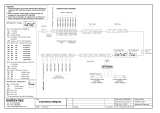
HIGH SPEED PULSE ISOLATION
RELAY INSTRUCTION SHEET
OUTPUT #2
CONNECTIONS TO METER
POWER SUPPLY
INPUT
MOUNTING POSITION - The RTR-2C may be mounted in any position.
POWER INPUT - Connect the "Hot" lead to the L1 terminal. The power supply is autoranging from 120 to 277VAC. Connect the
Neutral power supply lead to the NEU terminal. Connect the electrical system ground to the GND terminal. The unit must be
grounded for proper operation.
METER CONNECTIONS - The RTR-2C's Kin and Yin terminals are connected to the meter. The RTR-2C's Yin terminal is the
"pulled-up" +13VDC source which is connected to the "+" input of the meter. The Kin terminal is the system common return or
ground. Upon a closure of the meter's pulse switching device, the +13VDC Yin input line is pulled down to ground. The Amber
LED will light indicating that a pulse has been received. If the width of the input pulse is very short, the Amber LED may be
difficult to see. Assuming the pulse meets the input criteria, the Green LED will light, indicating that a pulse output switch has
closed, and thus a pulse output has occurred. Shielded cable is highly recommended between the meter and the RTR-2C input.
FUSES - The fuses F1 and F2 are type 3AG and may be up to 1/10 Amp in size. Two 1/10 Amp fuses are supplied standard with
the unit unless otherwise specified.
INPUT and OUTPUT CONFIGURATION - Under the RTR-2C's cover in the center of the board just below the lower fuse (F1) is
a 8-position DIP switch labeled S1. This DIP switch allows the input and output timing configurations to be set. Switch #1 sets
the Normal or Fixed output mode. Use the Normal mode to have the output pulse length match the input pulse length. The
normal mode is generally necessary for high speed and the length of the pulse varies with pulse speed. Use the Fixed mode for a
fixed output pulse width. Switches S5, S6 and S7 set the input filtering time. Any pulse less than the selected input filtering time
will be ignored and considered to be noise. Switches S2, S3 and 4 set the output pulse width if the Fixed mode is selected.
+13VDC pulled-up voltage TO meter
OUTPUT #1
NEUTRAL
SOLID STATE INSTRUMENTS
a division of Brayden Automation Corp.
6230 Aviation Circle, Loveland Colorado 80538
Phone: (970)461-9600
Revision: 3/16/2022 P/N: 05204-97006C3
K
Y
Common return FROM meter
RTR-2C
C-Series
Standard Solid State
120-277V HOT
GROUND
GAS/H2O
METER
-
+
Y2
K2
Yin(+)
Kin(-)
L1
Y1
K1
Typical Form A
dry contact
Output circuit
F2
NEU
GND
Y2K2YinKinL1 Y1K1NEUGND XVIO
XVin
Output LED
Input
LED
N/C
Pulse
GND
Dry Contact compatible Input
Two dry-contact solid state outputs
See page 3 &4 of this sheet for additional information on selecting system settings. Transient suppression for the contacts of the
solid state relay is provided internally.
TEST MODE - The RTR-2C includes a test mode to be able to detect very short width input pulses. Enable the test mode by
putting Switch 8 of S1 in the UP position. In this position, once a pulse is detected, it will latch on the RED LED to indicate that
a pulse has been detected. Cycle the power to reset the LED. The test mode will detect pulses down to 25 microseconds. Put
Switch 8 in the DOWN position for normal operation and reset the RED LED.
Pulse Detect LED (Test)
Output Overflow (Normal)









